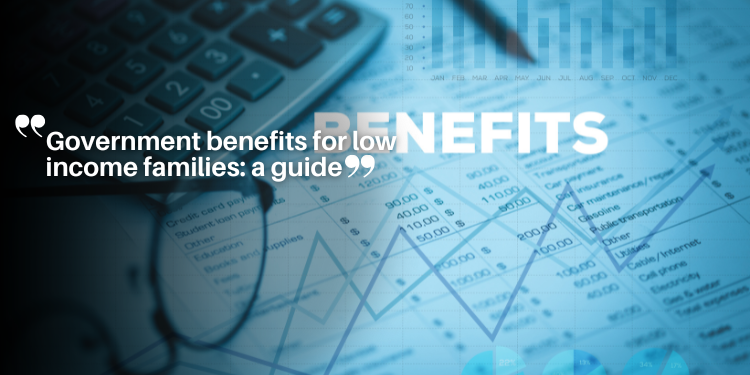Government benefits for low income families: a guide

Government benefits for low income families provide essential support such as cash assistance, food aid, and healthcare coverage, aimed at improving their quality of life and meeting basic needs.
Government benefits for low income families can be a lifeline for many, offering support in times of need. Have you ever wondered what assistance is out there? Let’s break it down.
Understanding government benefits
Understanding government benefits is essential for low income families. These benefits can provide crucial support to help navigate financial challenges. Knowing what is available can make a significant difference in your life.
Types of Government Benefits
There are various kinds of benefits that you might qualify for. Each serves a different purpose and can assist in unique ways. Some of the main categories include:
- Cash Assistance: Programs like Temporary Assistance for Needy Families (TANF) provide direct cash support.
- Food Assistance: The Supplemental Nutrition Assistance Program (SNAP) helps families afford groceries.
- Housing Assistance: Programs help with rental costs and provide safe living environments.
- Healthcare Coverage: Medicaid and the Children’s Health Insurance Program (CHIP) ensure medical care.
Each of these benefits is designed to help families meet their basic needs and improve their quality of life. Applying can sometimes seem overwhelming, but understanding the options can ease the process.
Eligibility Criteria for Benefits
Eligibility for these programs often depends on your income, family size, and specific circumstances. Most programs require you to provide documentation to verify your situation. Here are some common factors considered:
- Your total household income.
- The number of people living in your home.
- Current employment status.
- Citizenship and residency status.
It’s important to check the requirements for each program, as they can vary by state. Additionally, families can be eligible for multiple programs at once, which can enhance the support they receive.
In conclusion, understanding government benefits allows families to access resources that can alleviate financial burdens. Utilizing these programs effectively can lead to a more stable future.
Types of benefits available
There are many types of government benefits available for low income families. Each program serves a specific purpose, helping families meet essential needs. Understanding these benefits is vital for making informed decisions about what support you may qualify for.
Financial Assistance Programs
Financial assistance programs provide much-needed relief for families struggling to make ends meet. One key program is Temporary Assistance for Needy Families (TANF), which gives cash assistance for daily expenses. Other programs can assist you with utilities or emergency funds.
Nutrition Assistance
Nutrition assistance is vital for ensuring families have access to healthy food. The Supplemental Nutrition Assistance Program (SNAP) offers monthly benefits to purchase groceries. It’s important to know that eligibility often depends on income and family size.
- Access to a wider range of nutritious foods.
- Support for special dietary needs, if applicable.
- Programs that help educate families about healthy eating.
All these elements help contribute to a healthier lifestyle for families.
Healthcare and Medical Support
Access to healthcare is a critical aspect of well-being. Programs like Medicaid and the Children’s Health Insurance Program (CHIP) provide free or low-cost medical care for qualifying families. These services can cover:
- Routine check-ups and vaccinations.
- Emergency medical services.
- Prescriptions and ongoing treatments.
Ensuring that families can receive necessary medical care helps prevent higher costs down the road.
Education benefits can also play a significant role. Programs designed for low income families often include assistance with purchasing school supplies, tuition fees, and childcare. These benefits help foster a supportive learning environment for children.
Exploring these various types of government benefits can empower families to leverage available support and improve their general quality of life.

Eligibility criteria for assistance
Understanding the eligibility criteria for assistance is crucial for families seeking government benefits. Each program has specific requirements that determine whether a family can receive support. These criteria often include factors such as income, residency, and family size.
Income Guidelines
Most assistance programs look closely at your household income. Each program sets an income limit, which varies depending on the number of people in your family. It’s important to gather documents such as pay stubs and tax returns when applying. These documents will help verify your income and ensure you meet the program’s guidelines.
Family Size and Composition
The number of individuals living in your household plays a significant role in determining eligibility. Larger families may qualify for more benefits compared to smaller ones. When applying, be sure to provide details about each member of your household. This helps authorities understand your situation better.
- Include all dependents when reporting family size.
- Provide information on any special circumstances.
- Changes in family status, like birth or adoption, can affect eligibility.
Additionally, some programs are designed especially for vulnerable populations, which may include single-parent families or families with disabled members. These populations often receive priority in assistance.
Residency and Citizenship Requirements
Eligibility also requires proof of residency. Most programs require applicants to be residents of the state in which they are applying. You may be asked to submit documents such as utility bills or lease agreements. Furthermore, citizenship status can be a factor. Generally, only U.S. citizens and certain legal residents are eligible for many benefits.
It’s essential to read through each program’s specific eligibility criteria thoroughly. Knowing what is required can streamline the application process. Keeping organized records and understanding your family’s situation will help you navigate the assistance landscape effectively.
How to apply for government aid
Applying for government aid may seem complicated, but breaking it down into steps can make it easier. Understanding the process is key to accessing the support you need. First, you’ll want to gather all necessary documentation.
Gather Required Documents
Before starting your application, collect essential documents such as identification, proof of income, and residency. Some commonly required documents include:
- Your Social Security number
- Pay stubs or tax returns for income verification
- Proof of address, like a utility bill
- Birth certificates for any children in the household
Having these documents ready will help streamline the application process.
Online Applications
Many government programs allow you to apply online. This can be a convenient way to submit your application from home. To get started, visit the official government website for the program you are interested in. Ensure you complete each section accurately and thoroughly.
While filling out applications, keep the following in mind:
- Double-check all entries for accuracy.
- Save your progress if you are applying online to avoid losing information.
- Follow up on your application if you do not receive a confirmation.
This proactive approach can help prevent delays in processing your application.
In-Person Applications
If you prefer face-to-face assistance, you can apply in person at local government offices. Many community organizations also provide support and guidance on the application process. Visiting these resources can offer personalized help and answer questions.
When applying in person, bringing the same documents mentioned earlier is essential. Meeting with a representative can clarify any misunderstandings and assist in ensuring your application is filled out correctly.
Some programs even offer multilingual assistance, so don’t hesitate to ask for support in your preferred language. Overall, the application process for government aid is manageable with the right preparation and support.
FAQ – Questions about government benefits for low income families
What types of assistance can low income families receive?
Low income families can receive assistance such as cash aid, food support through SNAP, healthcare coverage, and housing assistance.
How can I determine if I’m eligible for government benefits?
Eligibility is usually based on household income, family size, and residency. It’s important to review specific program requirements.
What documents do I need to apply for government aid?
Common documents include identification, proof of income, proof of residency, and social security numbers for all household members.
Can I apply for government benefits online?
Yes, many government programs allow you to apply online. Make sure to visit the official website for detailed instructions.







